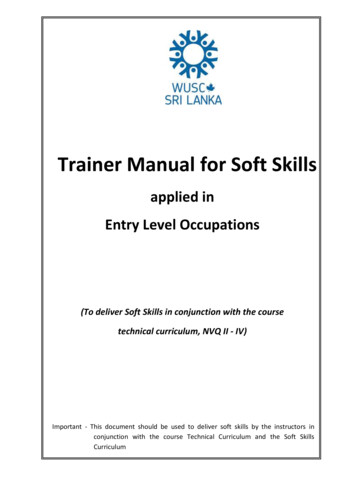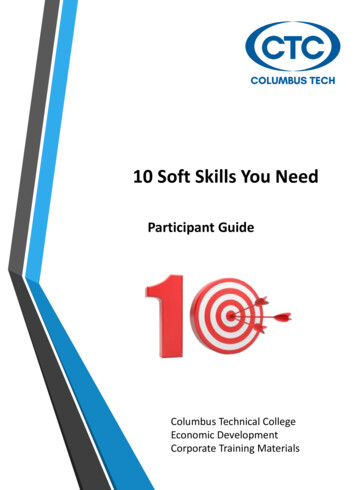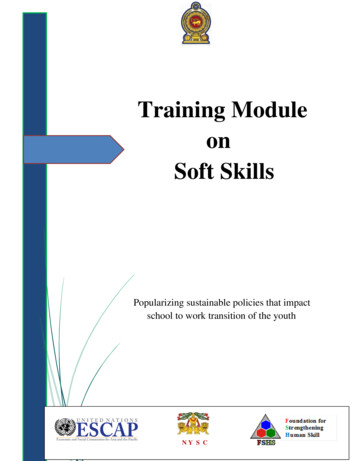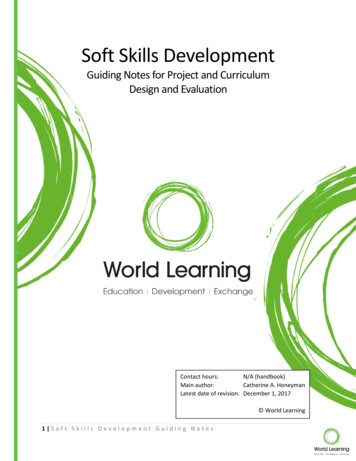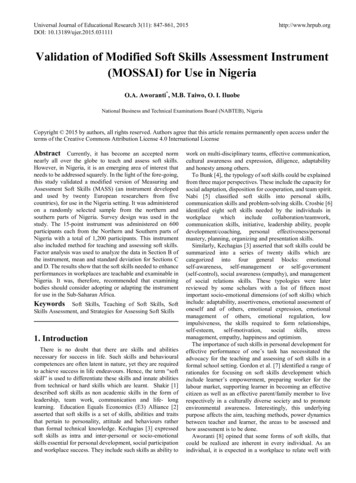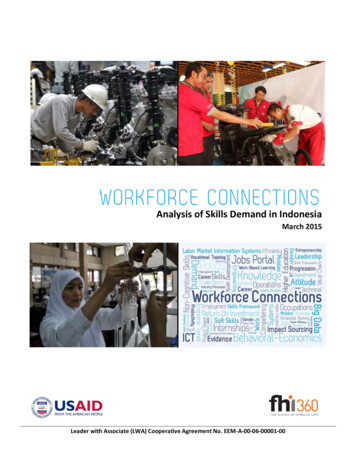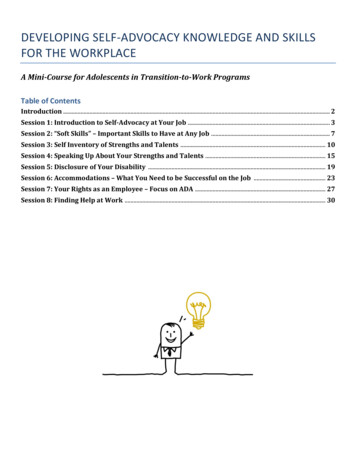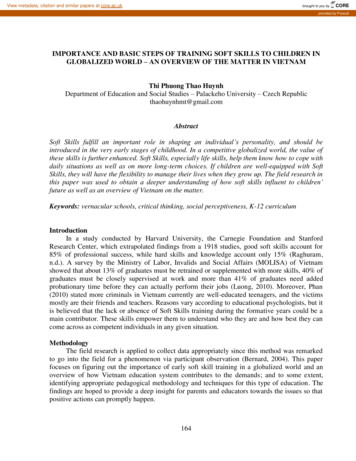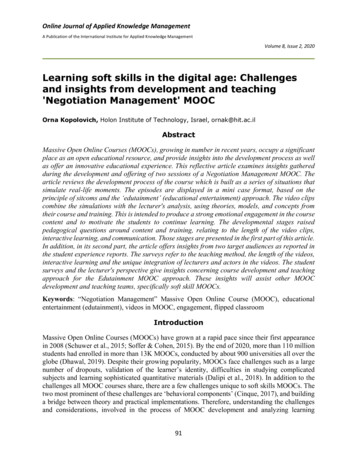
Transcription
Online Journal of Applied Knowledge ManagementA Publication of the International Institute for Applied Knowledge ManagementVolume 8, Issue 2, 2020Learning soft skills in the digital age: Challengesand insights from development and teaching'Negotiation Management' MOOCOrna Kopolovich, Holon Institute of Technology, Israel, ornak@hit.ac.ilAbstractMassive Open Online Courses (MOOCs), growing in number in recent years, occupy a significantplace as an open educational resource, and provide insights into the development process as wellas offer an innovative educational experience. This reflective article examines insights gatheredduring the development and offering of two sessions of a Negotiation Management MOOC. Thearticle reviews the development process of the course which is built as a series of situations thatsimulate real-life moments. The episodes are displayed in a mini case format, based on theprinciple of sitcoms and the ‘edutainment’ (educational entertainment) approach. The video clipscombine the simulations with the lecturer's analysis, using theories, models, and concepts fromtheir course and training. This is intended to produce a strong emotional engagement in the coursecontent and to motivate the students to continue learning. The developmental stages raisedpedagogical questions around content and training, relating to the length of the video clips,interactive learning, and communication. Those stages are presented in the first part of this article.In addition, in its second part, the article offers insights from two target audiences as reported inthe student experience reports. The surveys refer to the teaching method, the length of the videos,interactive learning and the unique integration of lecturers and actors in the videos. The studentsurveys and the lecturer's perspective give insights concerning course development and teachingapproach for the Edutainment MOOC approach. These insights will assist other MOOCdevelopment and teaching teams, specifically soft skill MOOCs.Keywords: “Negotiation Management” Massive Open Online Course (MOOC), educationalentertainment (edutainment), videos in MOOC, engagement, flipped classroomIntroductionMassive Open Online Courses (MOOCs) have grown at a rapid pace since their first appearancein 2008 (Schuwer et al., 2015; Soffer & Cohen, 2015). By the end of 2020, more than 110 millionstudents had enrolled in more than 13K MOOCs, conducted by about 900 universities all over theglobe (Dhawal, 2019). Despite their growing popularity, MOOCs face challenges such as a largenumber of dropouts, validation of the learner’s identity, difficulties in studying complicatedsubjects and learning sophisticated quantitative materials (Dalipi et al., 2018). In addition to thechallenges all MOOC courses share, there are a few challenges unique to soft skills MOOCs. Thetwo most prominent of these challenges are ‘behavioral components’ (Cinque, 2017), and buildinga bridge between theory and practical implementations. Therefore, understanding the challengesand considerations, involved in the process of MOOC development and analyzing learning91
Online Journal of Applied Knowledge ManagementA Publication of the International Institute for Applied Knowledge ManagementVolume 8, Issue 2, 2020patterns, might provide important insights for lecturers interested in developing MOOC courses orusing them in class. Certainly, this reflective article attempts to fill the absence by presenting theauthor's insights as a creator and lecturer of the “Negotiation Management” MOOC. Thecourse was developed as part of an award, by a National Project for Digital Learning. The courseis on a digital platform named Campus IL (https://campus.gov.il/en/about/), enabling free MOOCsbased on the edX platform. Numerous insights were gathered while developing the course; the firstand main part of the article will describe the course and its development, while presenting differentchallenges and insights related to the process. In this section, the process of creating video clips isaddressed, interactive learning, and communication between the instructors and students. Later,insights regarding the teaching of the course will be shared, as they were reflected in students’feedback and, from the author's perspective, as a lecturer and the course’s director. At the verymoment of writing this article, the third version of the course is running, in which most insightsmentioned above have been implemented. In addition and further to the feedback, content wasadded, such as; preparing for job interviews and advanced topics sections to some units.Pedagogical and Didactic Aspects of Teaching Soft Skills in Generaland in NegotiationSoft skills, commonly defined as non-technical skills, enable individuals to interact effectively andcooperatively with others. The ‘World Economic Forum Report: Mapping Opportunity in the NewEconomy’ (2020), takes an in-depth look, shifting the focus of employment to emergingprofessions of the future. The report shows a clear demand for both hard and soft skills, statingthat “the transition to the new world of work will be both human and tech-centric” (p. 18). Smartertechnology requires softer skills. These skills are vital to organizations and can impact culture,mindsets, attitudes, and behaviors throughout an enterprise. The recognition of soft skills as anecessary discipline has increased in recent years. The same trend applies to the understandingthat those skills have beyond academic or technical knowledge (Schulz, 2008).Negotiation management as a soft skill, was also found to be a predictor of professional success,and related to attributes, such as leadership and effective management (Deming 2018). In the lastdecade, there has been a significant increase in teaching negotiation management, both in academicand professional training programs. Currently, tens of billions of dollars are spent every year onnegotiation and soft skills training. Yet, little systemic research has been conducted on the actualeffectiveness of negotiation training, (Ebner, 2016). Major criticism of most negotiation trainingprograms, is for not basing their instruction on a well-established body of theory (Andrew &Meligrana, 2012). As an academic discipline, Negotiation Management is a comparatively new,multidisciplinary field. It seems that it has required a more organized teaching method for years(Lewicki, 1986). There is an absence of a clear methodological discussion regarding the teachingmethods, which could allow the practical implementation of the existing theoretical discussion.And even in the application of role-playing simulations which is among the most researched topics,there is an absence of a well-established theory on the subject (Ebner, 2016).The "Negotiation Management" MOOCThe Negotiation Management course was developed by the author over two decades ago, and wastaught frontally for many years in classroom sessions that combined lecture with practice throughsimulations and role play. The course aims to impart research-based knowledge and skills in92
Online Journal of Applied Knowledge ManagementA Publication of the International Institute for Applied Knowledge ManagementVolume 8, Issue 2, 2020negotiation, to understand complex negotiation processes and to allow learners to build a ‘personaltoolbox’ that will allow them to negotiate optimally. In addition, the course establishes theunderstanding that negotiation is a skill that all need and use every day, in a wide variety ofsituations, in our personal and professional life. Course topics include: “Identify conflicts andresolve them through negotiation”; “Getting to yes' Principled negotiation”; “Conflict negotiationstyles”; “Negotiation strategies and tactics”; “Addressing objections in negotiations”; “Culture andcross-culture negotiations”; and “Non-verbal communication” (‘body language’) (Ilan et al.,2020).The development and production were done at Holon Institute of Technology (HIT), an academicinstitution of higher education in Israel, and took approximately a year. The first delivery of thecourse was in the fall of 2018. To date, three rounds of free MOOC and nine rounds of the academicsessions have been taught, to approximately 13,000 participants. The course is asynchronous,meaning students could log onto the course at any time, study, engage and participate, regardlessof time zones, work hours, and family commitments. The MOOC is offered in Hebrew, in twomodes: The first mode is as a free instructor-led MOOC. The second mode is a blended academiccourse for the HIT students that combines five face-to-face meetings in flipped classroomapproach. The latter is independent learning from textbooks and various multimedia materialswhich integrates traditional models and classroom activities (Kurtz, 2014). From the early stagesof development, the development team was driven by two main questions: The first is about howto teach soft skills, with all the complexity of human behavior, via MOOC courses, whiletransforming the soft skills theory and models, into a life toolbox. In other words, how do we linktheory and practical implementations? The second research question deals with the major dropout issue all MOOCs face. How does the course preserve the interest and engagement of thelearners, and lower the high dropout rate?Indeed, the first motivation was to solve the question: how can negotiation skills be taught througha MOOC course, and how can learners understand those skills in the context of their dailylives. The main challenge in developing a digital course was to construct the bridge between theoryand practical implementations. It was done by designing educational content that createscomplicated situations, while including a multitude of perceptible and understandable behavioralcomponents. The end-result presents an authentic and complicated environment in whichnegotiation takes place, so that the learners will be given practical and relevant-to-all knowledge(Ilan et al., 2020). This is also relevant to our second motivation: based on the common notion thatwhen learners are more motivated to learn, they are likely to better engage and have a higherlikelihood of completing a MOOC (Lee & Martin, 2017). The aspiration was to encourage learnersto take part in the content, hoping that it would provide a solution to the second question as well.Finding an answer to our second question is extremely important because, despite the advantagesof MOOCs, their course completion rates are lower than those of other learning environments(Reich & Ruipérez-Valiente, 2019). Both questions are related to the development process as wellas to the teaching phase: how to engage learners, make them see the relevance and usefulness ofthe course for their lives, and increase their motivation and commitment for learning.Acknowledging that persistence levels play a key role in learners’ performance has guided us inthe course development process.93
Online Journal of Applied Knowledge ManagementA Publication of the International Institute for Applied Knowledge ManagementVolume 8, Issue 2, 2020MethodologyThe basis of this chapter is to document the “knowledge of practice”, with the aim of advancingknowledge and insights and improving practice in the field (Cochran-Smith & Lytle, 1999). Themain research tools are the documentation of the process done and the researcher's reflection as iscommon in action research (Clark & Peterson, 1986). The reflective perspective, based on thedeveloping process, is intended to complement knowledge and insights that emerged mainlyduring the development phase. From this angle the process is viewed from the outside inward,offering a unique perspective and outlining the limitations of the chapter. The first part of thechapter presents the development process from the lecturer’s perspective. The second part presentsthe findings relating to the learning process and is based on quantitative and qualitative metrics.The data is based on feedback from the course completion of 405 external students and 96classroom students. The insights are mostly based on the students' comments in the open sectionof the feedback and the lecturer’s teaching experience.Insights on learning habits can be gathered using data analysis provided by real-time informationon the learning patterns, of large heterogeneous groups of users, and by examining them. Still,there is an absence of instructor perspective insider information regarding the planning process ofthe MOOC and effective learning design (Drachsler & Kalz, 2016). Insights on learning habits canbe collected through analysis of analytical applications (data mining), which provide real-timeinformation about the number of participants and the learning patterns of large and heterogeneousgroups of students in a MOOC. These figures measure the degree of involvement in learning andpredict the chances of success in the course (Gaševićet et al., 2016). They also provide manyopportunities to measure performance in different aspects of teaching and learning (Jorno &Gynther, 2018). However, it should be noted that the optimal combination of analyticalinstruments in the instructional-studies process is still evolving, especially in the context ofcontinuous data collection and analysis throughout the learning period (Mattingly et al., 2012).Moreover, there are almost no useful models or practical advice for effective use of the analyticaltools to support and improve learning and prevent dropouts (Arnold & Pistilli, 2012; Conijn et al.,2018). Therefore, despite the well-known limitations of action research, it still brings an internalperspective, which is another component towards building a body of knowledge that will helpdevelopers and lecturers (Arnold, 2010).Course Development ProcessCourse DescriptionThe development team included experts from related, but not identical fields, (Psychology,Cinematography, Techno-Pedagogy, & Education), and the author, as negotiation managementexpert. The variety allowed the team to examine the content from different perspectives. Thestarting point was a standard academic course taught by the author at HIT for two decades. Theresult, a completely new and completely different course, suitable for digital mediums andheterogeneous target audiences.The process of knowledge mapping and selection of topics to be included in the course was basedon the research by Honeyman et al. (2004), who identified six key issues that they claimed to94
Online Journal of Applied Knowledge ManagementA Publication of the International Institute for Applied Knowledge ManagementVolume 8, Issue 2, 2020include in negotiation courses. The development team decided to add more topics relevant to thetarget audience and culture, such as: cross-cultural and multicultural negotiations and non-verbalcommunication. The next step, which was long and deliberate, was to decide the course design.The easiest choice would have been a fairly simple course design that would deliver basic content:a top-down course, relying only on videotaped lectures as sources of information, self-paced, withlittle interaction between teacher and students and even less between classmates, with little teacherintervention in real time, and no interactive exercises requiring close monitoring such asnegotiation simulations (Ebner, 2016). All the courses reviewed in the first phase were conductedusing this method. Content design in this way is common in MOOC courses and relatively simpleto execute. However, it did not provide a satisfactory response to the goals set by the team. It wasimportant to show how relevant and necessary negotiation skills are in a variety of everydaysituations, to generate learners' interest and engagement in the learning process and address theproblem of learner dropout typical of MOOC courses. In addition, due to the complex nature ofnegotiating skills and the multitude of intervening factors, it was decided to use video clips thathave the ability to convey a situational simulation, in which the learner can experience complexand multivariate situations (Chesler et al., 2015) and engage him in the learning process (Chen, etal., 2019). Therefore, the development team chose to design the course in the Edutainment(Educational Entertainment) approach, a hybrid genre that combines learning and fun (Okan,2011), education and entertainment (Gros, 2003), and relies on visuals, story or game-like formats,and less formal address styles or didactic style (Buckingham & Scanlon, 2000). Pedagogically, theapproach is based on several key principles including: relevance of the content as beneficial to thetarget audience, incremental learning done in a timely and timely manner for learners andpresentation of knowledge in a way that is easy for learners to absorb it (Zin & Zain, 2010). Theedutainment approach was chosen based on the advantages mentioned above. It should be noted,that negotiation educators have long considered the use of role-play simulations as an essentialclassroom teaching method, and have had high expectations regarding their suitability and efficacyfor teaching. (Druckman, & Ebner, 2013). Asynchronous edutainment takes role-playing a stepfurther and therefore is still in its innovative stages and needs more research in relation tonegotiation management. Consequently, a series of episodes representing everyday situations wascreated. In the characterization and development phase, topics were outlined to include variousaspects to examine concerning each topic. Then the characters who would present the situationswere defined. The situations are presented by four main actors (three of whom play studentsworking in the campus cafeteria, the fourth as cafeteria manager) and guest actors. Each of themain characters represents personal and behavioral characteristics, reflecting typical behavioraccording to the models and theories studied (Ilan et al., 2020). The challenge was to createcharacters that would be interesting and complex, but also authentic. After each episode, thelecturer analyzes it, abstracts and generalizes the situations using theories, models and concepts ofthe course. Each episode has its plot but from episode to episode the fabric of the relationshipweaves itself, and the characters undergo changes together. The discourse between the charactersrevolves around negotiating situations from the learners' personal and work lives. These situationspromote authentic learning (Horizon report preview: Higher education edition, 2018), whichstimulates identification with the characters, and curiosity about their relationship. As a result, thelearners develop a strong emotional involvement with the course content and motivation tocontinue learning and it contributes to their engagement levels (Guo et al., 2014).95
Online Journal of Applied Knowledge ManagementA Publication of the International Institute for Applied Knowledge ManagementVolume 8, Issue 2, 2020Figure 1. From 'Real Life Moments' to a Theoretical ModelBased on research recommendations, the course has eight modular units of the same structure(Kopp & Lackner, 2014), each unit stands on its own while, also linked to the other units, thusproducing a synergy of knowledge and process. At the end of each learning unit, the participantsare required to perform a task or answer a multiple-choice quiz that examines the level ofknowledge and understanding of the content studied.The writing process included many discussions and consultations between the development teamto create authenticity in the writing. In addition, much of the content was tested at variousdevelopment stages, on small focus groups, which included about ten people of different ages,some students. The comments gathered in these groups brought further accuracy in writing. Inaddition, three main components were emphasized: (1) Video clips, (2) interactive learning, and(3) communications, which are further discussed below.Video ClipsVideo watching learning is used in a wide spectrum of instructional settings, ranging from theflipped class model (Kurtz et al., 2014), online learning and MOOCs (Guo et al., 2014). It issuitable for soft skills learning due to its complex nature and multitude of interfering factors(Koedinger et al., 2015). Videos convey a situational simulation where the learner can experiencecomplex and multivariate situations, and bring them into the learning process (Chen et al., 2019;Chesler et al., 2015). Much thought was invested in the design of the videos with reference to thecontent and the visual environment, structure, and length of the videos.As mentioned before, the four actors were photographed at several locations, mainly outdoorphotography in natural settings, with the aim of producing authentic “life moments”. Lecturershots were conducted in a different setting than the actors, to create a distinction between situationsand their explanation. The location chosen for the lecturer’s photography simulates a workspace,with emphasis on soft lighting and minimal décor, which creates a pleasant and user-friendlyapproach. At the editing stage, the actors' videos were combined with those of the lecturer andmotion graphics were added on them. videos of the actors were also used to accompany thelecturer’s explanations by voice-over technique, by creating a brief flash of reminiscence from theexplained scene. The latter further supports the learning process and facilitates the understandingof the explanation (Bannert & Mengelkamp, 2013; Lin & Lehman, 1999).96
Online Journal of Applied Knowledge ManagementA Publication of the International Institute for Applied Knowledge ManagementVolume 8, Issue 2, 2020Figure 2. The Actors Setting: Natural and AuthenticIn the design and the editing phase, close attention was paid to the videos. Initially, the six-minutevideo “myth” was adopted as an ideal time (Geri et al., 2017), but additional considerations, suchas the level of difficulty and complexity of the content being studied, the dynamic of the scene(especially because most of the videos incorporate episodes of the actors, the lecturer'sexplanations and, graphic effects), place the video within the study unit and the like. Still, the videounits were kept short and dynamic and, following Gou et al. (2014), adhered to a friendly andinformal style that would allow learners to identify and raise the level of engagement.Interactive LearningInteractive learning has been essential for years (Moreno & Mayer, 2007). While watching videosalone is considered a passive form of learning (Chi, 2009), it is necessary to integrate interactiveactivities such as short exams, discussion forums, etc., to increase learner engagement (Mitrovicet al., 2016) and the level of attention (Cherrett et al., 2009; Kim et al., 2014). In our case, thesecombined; learning strategies, careful planning and creative thinking required at every stage,planning every detail of active learning as self-contained and at the same time integrating with theentire course image and contributing to the process. The campus platform enables the use of manyinteractive tools, of which the team have mainly chosen to use the Quiz (Tester) assessment, whichallows assessment through multiple-choice closed questions, which include instant and automaticfeedback, designed to strengthen understanding and continue the learning process. There areexams at the end of each unit and at the end of the course, there is a concluding test.CommunicationInteractions, particularly between the instructors and students, were found to be a significant factordetermining student engagement and, thus, increasing the completion rate (Hew, 2015; Hone & ElSaid, 2016). The aim was to create customized communication channels for each of our targetaudiences: All the learners had the discussion groups in the course forum, a course team email,and a dedicated Facebook group set up for the course. And the enrolled students could alsocommunicate with us through a Moodle model system, which is the medium of communicationfor all courses at the institution.Insights and Practical Implications from the Development PhaseUnlike traditional teaching where the lecturer can spontaneously change the pace of teaching, orthe content according to the learner’s responses, the instructional design of MOOC should be preplanned for, in detail. In a virtual learning environment, it is more difficult to respond97
Online Journal of Applied Knowledge ManagementA Publication of the International Institute for Applied Knowledge ManagementVolume 8, Issue 2, 2020spontaneously since teachers do not see their students' faces and behavior (Kopp & Lackner, 2014).Another engaging challenge that accompanied us throughout the design phase was the fact that thecourse is open to heterogeneous audiences and attracted a great number of learners. This requiredcareful planning for each component of the course and its connection to the other components.The development phase called for a break with existing knowledge and a new accuratereconstruction, paying close attention to many details: The script intended for the actors coversfactual content yet is not too didactic and leaves space for authenticity and identification withthem. The script written for the lecturer, conceptualizes and simplifies the episodes, in a friendlyand pleasant way that combines personal stories from the teacher's professional experience. Theproduction phase was extraordinarily complex and labor-intensive, most of the videos were filmedseveral times to achieve an exact result in both the message and the experience conveyed.The editing was done in cooperation with a professional editor and it combines many knowledgeitems and videos of the cast, lecturer and info-graphics, to highlight, explain and summarize thecontent visually. In the editing phase, there was extensive use of voice-over technique to createvisual anchors for the learners and keep them engaged. Great attention was paid to every secondto generate on-screen movement and ongoing interest for learners. In addition to the video clips, ashell of interactive exercises was integrated to the course platform and designed in two stages: inthe first stage, un-scored practice and in the second stage a practice with a score. In addition,original text units were written to enrich the content for interested learners.In the work process, the team incorporated dimensions of assessment and control, which werereflected in both the experts' comments and feedback. Following the many discussions, the writingwas refined and the course design improved to the final version. One of the teaching team's goalswas that each of the eight lessons would stand on its own, and at the same time blend in with theother lessons to form an overall picture. In addition, the relationship between the characters as aframe story evolves from lesson to lesson and becomes a multi-component frame story. Thisrequired macro and micro thinking at all times. Designing the course as Edutainment was the mostsignificant challenge, mainly because there was no example of such a course to learn from. Thisrequired a two-way mindset, one that would bring learners the most meaningful content to learnnegotiation management, but at the same time, tell the story in an accessible and lighthearted way.Teaching the CourseThe findings and discussion in this section are based on quantitative and qualitative Indicators inthe reports of external learners registered students as evidenced by the graduation feedback, whichincluded 405 external learner feedbacks and another 96 classroom registered student feedbacks.The External LearnersThe self-report data shows that it is a heterogeneous group, with a wide age range between 18-86,some with a college education and some without. About 40% of them stated that they had a hightechnology orientation, while about 20% stated they had none whatsoever. Since the externallearners did not have the opportunity to share their learning experience, as HIT students did, it wasof importance to analyze external comments on the various components of the course in the finalfeedback:98
Online Journal of Applied Knowledge ManagementA Publication of the International Institute for Applied Knowledge ManagementVolume 8, Issue 2, 2020Platform: During the course session and especially in the first lecture, many questions arose fromthe lack of technological and self-learning skills, but these subsided as the course progressed. Inthe summary feedback, about 58% of learners stated that after getting used to the system, it waseasier for them to focus on learning and enjoying themselves.Content: about 85% of learners stated that the course contributed to their understanding or theirconduct in negotiations. A recurring comment in open-ended feedback, in various formulations,referred to the fact that the content presentation format helped them understand issues theyconsidered complex. “It always seemed to me that negotiation is something complex and difficultto learn. The course simplifies things and makes it possible.”The combination of actors and lecturer received a great deal of attention from the learners. In theopen comments, they noted, for example: “There was a feeling that you are not at all in an academiccourse but a television series”; “the characters are real and easy to identify with”; “Thecombination of the scenes with the lecturer’s explanations was innovative and contributed to theunderstanding”; and “the lecturer is interesting, pleasant and easy to follow.” About one-third ofthe survey respondents stated their desire for a face-to-face meeting for further practice of thematerial.Some learners shared their learning process with us. Results showed that some choose to studywith a family member or co-worker, with whom they scheduled a predetermined time, to view thelesson, usually once a week. This appears to address the
Learning soft skills in the digital age: Challenges . negotiation and soft skills training. Yet, little systemic research has been conducted on the actual . The latter is independent learning from textbooks and various multimedia materials which integrates traditional models and
